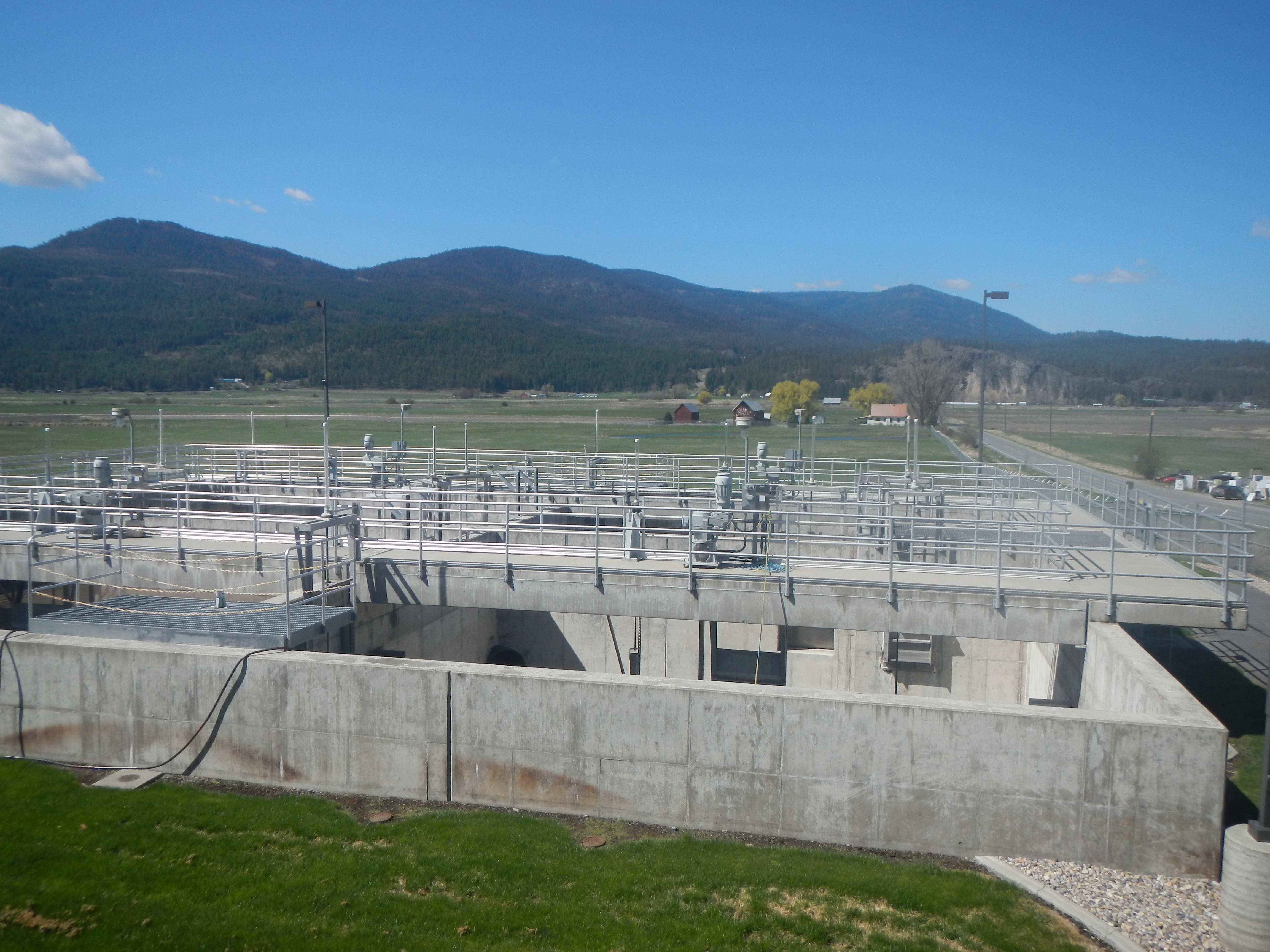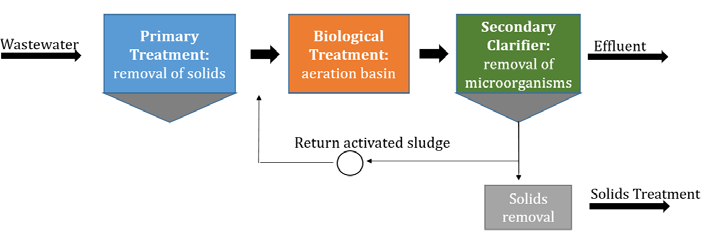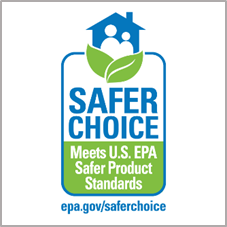
Wastewater treatment plants, like the one pictured here, are one of the ways CECs enter the water.
In response to recommendations by the Southern Resident Orca Task Force, Ecology is sharing research on the potential benefits of wastewater treatment technologies to reduce the amount of Contaminants of Emerging Concern (CECs) entering Washington water. In preparing this new paper, we gathered and reviewed previously published research results, case studies from Europe, many studies in Washington, and consulted with regional experts to provide an overview of the science behind removing CECs from wastewater. We reviewed over 280 scientific studies and compiled the results on how effective some wastewater treatment technologies are at removing common CECs.
We concluded that technologies that increase the length of treatment time also increase the chances of removing more CECs. This is because CECs tend to be large, complex chemicals that require extra time to break down. Some of the technologies that reduce nutrients in wastewater are also likely to reduce CECs because many of the nutrient removal technology options increase the time wastewater is in treatment.
Read our paper on Contaminants of Emerging Concern and Wastewater Treatment Technologies.
What are Comtaminants of Emerging Concern?
CECs are chemicals, both natural and synthetic, found in common products, such as pharmaceuticals and personal care products. There are over 40,000 chemicals in commerce, each with the potential to be contaminants of emerging concern. The problem is, we just don’t know enough about all of these chemicals to understand if they are harmful for the environment.
CECs can end up in wastewater through common activities like washing clothes, flushing the toilet, bathing, and maintaining and cleaning a home or business. CECs also reach wastewater from industrial processes, hospital waste, and recreational activities or settings like parks (i.e., boat washing and rinse off stations).
There are more than 2.8 million households in Washington that produce wastewater. This number does not include industrial sectors, office buildings, and other commercial areas that are connected to wastewater treatment facilities and can contribute CECs other than pharmaceutical and personal care products.
Why this matters
There are over 20,000 prescription drugs and personal care products approved by the Food and Drug Administration (FDA). While these products have a positive impact on quality of human life and provide lifesaving treatments, one unintended result is some of these products are also making their way into Washington’s water. The introduction and accumulation of personal care products are becoming an environmental concern in the state. Many of them can be toxic to aquatic life and/or bioaccumulate in the food chain, similar to mercury. When exposed to toxic chemicals aquatic life may also experience lethargy, reduced fertility, cancer, and death.
What did we compare?
In our paper, we looked at 15 different treatment technology types and compared how much of four common CECs they removed (measured by percent removal).
We chose the CECs listed below because they are commonly used as representative CECs in many studies and have published removal rates for many types of technologies. Additionally, these CECs are common in wastewater and span the range from easy to remove (caffeine, ibuprofen), to hard to remove (triclosan), to extremely difficult to remove (carbamazepine):
- Caffeine (that many of us know and love) is a naturally occurring chemical used as a stimulant of the brain and central nervous system. Caffeine is often used in wastewater treatment technology studies because it is ubiquitous.
- Ibuprofen is a nonsteroidal anti-inflammatory drug that works by reducing hormones that cause inflammation and is used to reduce fever and pain.
- Triclosan is an antibacterial and antifungal agent that was added to many consumer personal care products such as toothpaste, antibacterial soaps, and body washes. The FDA banned the use of Triclosan in 2016 in consumer products, but it can still be found in clothing, kitchenware, toys, and as a pesticide.
- Carbamazepine is an anticonvulsant/analgesic drug used to treat seizures, mania, and neuropathy. It is often used in studies that test how effective technology is because it is well known to be extremely hard to remove from wastewater.
For each treatment technology type we summarized how it works, what the research says about how well it removes CECs, and listed the advantages, disadvantages, nutrient removal capabilities, and published CEC removal rates.
How does wastewater treatment work?
There are over 300 domestic wastewater treatment plants in Washington, and they use many types of treatment technology and processes to meet water quality standards. Modern treatment plants do a good job at removing most of the stuff people flush down a toilet or send to a sewer system. They typically remove more than 85% of the solids, biodegrade some pollutants that enter the facility, and disinfect the water to kill most pathogens (bacteria and virus). While treated wastewater meets appropriate water quality standards, it is not pollution-free.
Treatment systems range from small, passive systems to large advanced treatment systems at wastewater treatment plants.
Rural or small communities often do not have centralized wastewater treatment systems. Centralized systems are impractical in these areas because of the smaller amounts of wastewater created, the distance or terrain that makes it difficult to transport waste. These communities treat their wastewater closer to the source and rely on smaller, decentralized systems like septic systems, which are not complicated to operate.
Larger communities have wastewater treatment plants that use a combination of technologies and processes together.
Biological treatment uses bacteria and fungi to decompose materials. You can think of “activated sludge” like sourdough starter that you keep alive separately and add to your dough to make bread.
Conventional wastewater treatment typically involves primary treatment to remove most solids, a biological treatment where microorganisms like bacteria and fungi decompose material, secondary clarification to both recycle and remove excess microorganisms for solids treatment, and disinfection. Some wastewater treatment plants now use advanced treatment technologies that have additional processes to remove more nutrients and CECs. Advanced wastewater treatment refers to any treatment beyond conventional (secondary) treatment, such as enhanced nutrient removal, chemical addition, filtration, and advanced oxidation.
We found that some of these advanced treatment technologies such as carbon filtration, ozonation, and reverse osmosis were the most successful at removing CECs.
What is the solution for keeping CECs out of the water?
Washingtonians can work on preventing CECs from even entering wastewater by properly disposing pharmaceuticals, avoiding the use of harsh chemicals while cleaning, and purchasing EPA Safer Choice products.
When EPA’s Safer Choice Logo is displayed on products it indicates that it contains only the safest possible ingredients.
We found that most treatment systems do reduce the amount of CECs in wastewater, (although the amount is different for each technology type). However, the chemicals are not entirely removed.
There is no “one size fits all” approach to CEC removal because CECs have very different chemical characteristics and there are so many CECs in common use that there is often insufficient data on what chemicals and how much of them are in the wastewater. Additionally, the treatment technologies that are available can have highly variable removal rates for the same compound depending on the season, the day, location of the WWTP, or the chemical make-up of the wastewater coming into the plant. Some compounds are extremely difficult and can only be removed by complex and expensive advanced treatment technology like granular activated carbon, reverse osmosis, and ozonation.
While we may not be able to remove all CECs, many wastewater treatment technologies exist that have the ability to remove some amount CECs from wastewater.
Next steps
We are continuing to review the latest available science on this issue, work with state universities to develop a Washington-specific list of prioritized CECs, learn from other states as they navigate these issues, and support EPA as they continue providing necessary information to address CECs in local waters.



